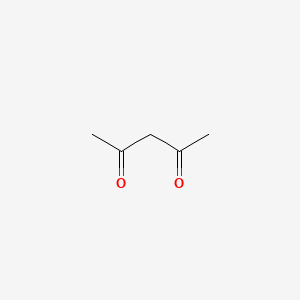| MeSH term | MeSH ID | Detail |
|---|---|---|
| Purpura, Thrombocytopenic | D011696 | 2 associated lipids |
| Eczema | D004485 | 4 associated lipids |
| Fetal Resorption | D005327 | 15 associated lipids |
| Carcinoma, Lewis Lung | D018827 | 22 associated lipids |
| Nervous System Diseases | D009422 | 37 associated lipids |
| Dermatitis, Contact | D003877 | 59 associated lipids |
| Seizures | D012640 | 87 associated lipids |
| Glioma | D005910 | 112 associated lipids |
| Edema | D004487 | 152 associated lipids |
| Adenocarcinoma | D000230 | 166 associated lipids |
2,4-pentanedione
2,4-pentanedione is a lipid of Fatty Acyls (FA) class. The related lipids are Butyrates.
Cross Reference
Introduction
To understand associated biological information of 2,4-pentanedione, we collected biological information of abnormalities, associated pathways, cellular/molecular locations, biological functions, related genes/proteins, lipids and common seen animal/experimental models with organized paragraphs from literatures.
What diseases are associated with 2,4-pentanedione?
There are no associated biomedical information in the current reference collection.
Possible diseases from mapped MeSH terms on references
We collected disease MeSH terms mapped to the references associated with 2,4-pentanedione
PubChem Associated disorders and diseases
What pathways are associated with 2,4-pentanedione
There are no associated biomedical information in the current reference collection.
PubChem Biomolecular Interactions and Pathways
Link to PubChem Biomolecular Interactions and PathwaysWhat cellular locations are associated with 2,4-pentanedione?
There are no associated biomedical information in the current reference collection.
What functions are associated with 2,4-pentanedione?
There are no associated biomedical information in the current reference collection.
What lipids are associated with 2,4-pentanedione?
Related references are published most in these journals:
| Lipid concept | Cross reference | Weighted score | Related literatures |
|---|
What genes are associated with 2,4-pentanedione?
There are no associated biomedical information in the current reference collection.
What common seen animal models are associated with 2,4-pentanedione?
There are no associated biomedical information in the current reference collection.
NCBI Entrez Crosslinks
All references with 2,4-pentanedione
Download all related citations| Authors | Title | Published | Journal | PubMed Link |
|---|---|---|---|---|
| Fondo M et al. | Dinuclear Co(III)/Co(III) and Co(II)/Co(III) mixed-valent complexes: synthetic control of the cobalt oxidation level. | 2006 | Dalton Trans | pmid:17047739 |
| Le Roux E et al. | Synthesis and characterisation of trigonal C2-chiral di- and tetra-substituted bis(oxazoline) alkyl zinc complexes and their reactivity towards protic reagents. | 2011 | Dalton Trans | pmid:21246135 |
| Kumar M et al. | Zinc complexes of Ttz(R,Me) with O and S donors reveal differences between Tp and Ttz ligands: acid stability and binding to H or an additional metal (Ttz(R,Me) = tris(3-R-5-methyl-1,2,4-triazolyl)borate; R = Ph, tBu). | 2011 | Dalton Trans | pmid:21706096 |
| Wittick LM et al. | New mixed-valence MnII2MnIII2 clusters exhibiting an unprecedented MnII/III oxidation state distribution in their magnetically coupled cores. | 2006 | Dalton Trans | pmid:16538272 |
| Ghanti E and Nagarajan R | Synthesis of CuAl2(acac)4(O(i)Pr)4, its hydrolysis and formation of bulk CuAl2O4 from the hydrolyzed gels; a case study of molecules to materials. | 2010 | Dalton Trans | pmid:20571649 |
| Edkins RM et al. | The synthesis and photophysics of tris-heteroleptic cyclometalated iridium complexes. | 2011 | Dalton Trans | pmid:21735008 |
| White H and Venkatesh B | Clinical review: ketones and brain injury. | 2011 | Crit Care | pmid:21489321 |
| Sterry W and Schmoll M | Contact urticaria and dermatitis from self-adhesive pads. | 1985 | Contact Derm. | pmid:4085238 |
| Gryllaki-Berger M et al. | A comparative study of formaldehyde detection using chromotropic acid, acetylacetone and HPLC in cosmetics and household cleaning products. | 1992 | Contact Derm. | pmid:1505179 |
| Flyvholm MA et al. | Comparison of 2 tests for clinical assessment of formaldehyde exposure. | 1996 | Contact Derm. | pmid:8789223 |
| Fregert S et al. | A simple method for the detection of formaldehyde. | 1984 | Contact Derm. | pmid:6713848 |
| Rostami-Charati F et al. | A facile one-pot synthesis of functionalized 1,3-oxathiolan-2-yliden derivatives: multicomponent reaction of oxiranes in water. | 2014 | Comb. Chem. High Throughput Screen. | pmid:23755720 |
| Sugiura M et al. | A simple colorimetric method for determination of serum triglycerides with lipoprotein lipase and glycerol dehydrogenase. | 1977 | Clin. Chim. Acta | pmid:589792 |
| Tomokuni K et al. | Optimized liquid-chromatographic method for fluorometric determination of urinary delta-aminolevulinic acid in workers exposed to lead. | 1987 | Clin. Chem. | pmid:3621570 |
| Pesce MA and Bodourian SH | Enzymatic rate method for measuring cholesterol in serum. | 1976 | Clin. Chem. | pmid:11901 |
| Okayama A et al. | Optimized fluorometric determination of urinary delta-aminolevulinic acid by using pre-column derivatization, and identification of the derivative. | 1990 | Clin. Chem. | pmid:2103726 |
| Cole SC and Kuwahara SS | Acetylacetone method for glycine improved by use of ammonium citrate buffer. | 1984 | Clin. Chem. | pmid:6733911 |
| Tishler PV and Winston SH | Simple screening test for qualitative detection of increased delta-aminolevulinic acid in urine. | 1984 | Clin. Chem. | pmid:6744588 |
| Meola JM et al. | Fluorometry of ethylene glycol in serum. | 1980 | Clin. Chem. | pmid:7428154 |
| Masson P et al. | Combined enzymic-Jaffé method for determination of creatinine in serum. | 1981 | Clin. Chem. | pmid:7449105 |
